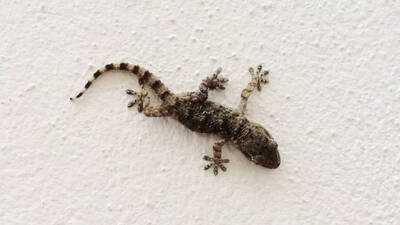
House lizards, especially the common house gecko, are frequent visitors in many Indian homes. While they are not as harmful as insects like mosquitoes or cockroaches, they can still spread bacteria such as salmonella, making it important to control their numbers indoors. One of the most effective ways to prevent a growing lizard population is by understanding where they lay their eggs. Lizards prefer warm, dark, and undisturbed corners that stay hidden from human activity, and these spots often become breeding hubs without being noticed. By identifying these common nesting zones early, homeowners can remove eggs before they hatch and stop multiple generations from multiplying. Knowing their egg-laying habits also helps you take simple preventive steps to keep your home clean, safe, and lizard-free.
House lizard mating season and egg-laying behaviour explained
House lizards reproduce mostly during warm and humid months, when the climate supports the survival and proper development of their eggs. After mating, the female begins searching for quiet, dark, and hidden corners that stay undisturbed by humans or predators. These protected spots help the eggs remain safe throughout the incubation period. A single female can lay two to three batches of eggs in one season, with each batch containing up to 20 eggs. The eggs usually take 40 to 60 days to hatch, and the young lizards need nearly a year to reach full maturity.
During egg-laying, the female prefers warm, slightly moist areas with steady temperatures, as sudden fluctuations can damage the embryos. The eggs themselves are small, round, white, and fragile, with a soft, leathery shell. Pink veins may appear as hatching approaches. Because females lay multiple batches, even one egg usually indicates several more nearby, making early detection essential for preventing infestation.

10 common places where house lizards lay their eggs
Basement corners
Basements are one of the prime nesting spots because they naturally offer all the conditions lizards seek: darkness, moisture, warmth, and multiple hiding zones. If the basement is cluttered with old furniture, boxes, or unused items, it becomes even more attractive as lizards can move around quietly without being noticed.
To prevent this, homeowners should keep basements well ventilated, fix dampness or leakage issues, and reduce clutter that provides hiding spaces. Sealing cracks and wall openings also stops lizards from entering through external gaps.
Under-sink cabinets
Kitchen and bathroom sinks constantly deal with water, making the area beneath them damp and humid. This moisture attracts insects, and where insects gather, lizards follow. The enclosed space under the sink is quiet, hidden, and usually undisturbed, ideal conditions for egg-laying.
Checking these cabinets regularly, fixing any pipe leaks immediately, wiping away moisture, and removing leftover food crumbs can all reduce the chances of lizards nesting here. Adding a small light or keeping the cabinet door open occasionally can also discourage them, as lizards avoid bright spaces.
Behind bookshelves and furniture
Large pieces of furniture such as bookshelves, wardrobes, or sideboards create dark, still zones that are rarely disturbed. These narrow spaces offer warmth and protection, making them ideal hiding or nesting areas. Lizards often slip behind these structures during the day and may lay their eggs there if they remain undisturbed for long periods.
To avoid this, it’s helpful to shift furniture slightly while cleaning, dust the back areas, and remove piles of newspapers or magazines that create additional hiding pockets.
Behind curtains and window corners
Curtains, especially thick or floor-length ones, create sheltered spaces between the fabric and the wall. Lizards hide here to avoid daylight and may choose the upper curtain rod area to lay eggs because humans rarely check that space. Window corners attract small insects at night, giving lizards nearby food as well. Cleaning curtain tops, checking window frames periodically, and sealing small gaps around windows can make this area less inviting.
Inside shoe racks and unused footwear
Closed shoe racks contain many compact, dark sections. Unused shoes, especially those left untouched for weeks or months, become hidden pockets where lizards may lay eggs. Footwear can trap moisture during humid weather, adding to the favourable environment.
To prevent this, keep the shoe rack tidy, avoid storing rarely used shoes for long periods, and place footwear in sunlight occasionally to remove moisture and pests.
Behind refrigerators and appliances
Large kitchen appliances produce warmth and are usually positioned close to the wall, creating narrow gaps where lizards can hide in comfort. The warmth from refrigerators, washing machines, and ovens can speed up egg development, making these spots attractive for nesting. Insects also gather around kitchen appliances, offering food for adult lizards. Moving appliances occasionally to clean the back and sides reduces insect activity and discourages lizards from nesting.
Inside wardrobes and cupboards
Wardrobes stay closed for long hours and contain warm materials such as clothes, bedding, or storage boxes. These undisturbed, cosy corners can attract female lizards seeking a safe nesting spot. They may hide behind drawers or inside unused storage bags or boxes.
Cleaning wardrobes regularly, improving lighting, and using mild repellents such as naphthalene balls can keep lizards away.
Attics and loft spaces
Lofts and attics are some of the safest spaces for lizards because humans seldom access them. These areas store cardboard, cloth, and other materials that create shaded hiding spots. Depending on the weather, attics may stay warm or humid, both conditions suitable for egg incubation. Inspecting lofts regularly, reducing clutter, maintaining airflow, and sealing entry points can help prevent nesting.
Behind wall hangings and photo frames
The small gap behind a wall painting, clock, or photo frame creates a secure hiding space for lizards. These areas offer shade and are rarely disturbed during daily cleaning. Checking behind frames during dusting and ensuring walls are well sealed prevents lizards from turning these narrow spaces into nesting spots.
Under beds and sofas
The area beneath beds or sofas is dark, quiet, and often collects dust and insects, ideal nesting conditions. Lizards may hide near the wall or inside structural gaps in wooden frames to lay their eggs. Regular deep cleaning under furniture and removing bags, boxes, or unused items helps keep this area unsuitable for nesting.
If you discover lizard eggs, it means active breeding is happening in your home. The safest approach is to contact professional pest control services. They can remove eggs safely, identify the nest source, and apply treatments that prevent further breeding. DIY removal often fails to solve the core problem and may lead to recurring infestations. Early action helps protect your home from long-term pest issues.
Also Read:
-
Kerala cop booked for molesting woman officer during duty

-
Shah Rukh Khan, Farah Khan break into ‘Chaiya Chaiya’ dance, make fans nostalgic

-
His struggle, sacrifice continues to inspire generations: PM Modi on Birsa Munda's 150th birth anniversary

-
Tragic Explosion at Nowgam Police Station Claims Eight Lives

-
Delhi-NCR turns into gas chamber as pollution remains in 'severe' category, AQI crosses 400-mark in several areas
